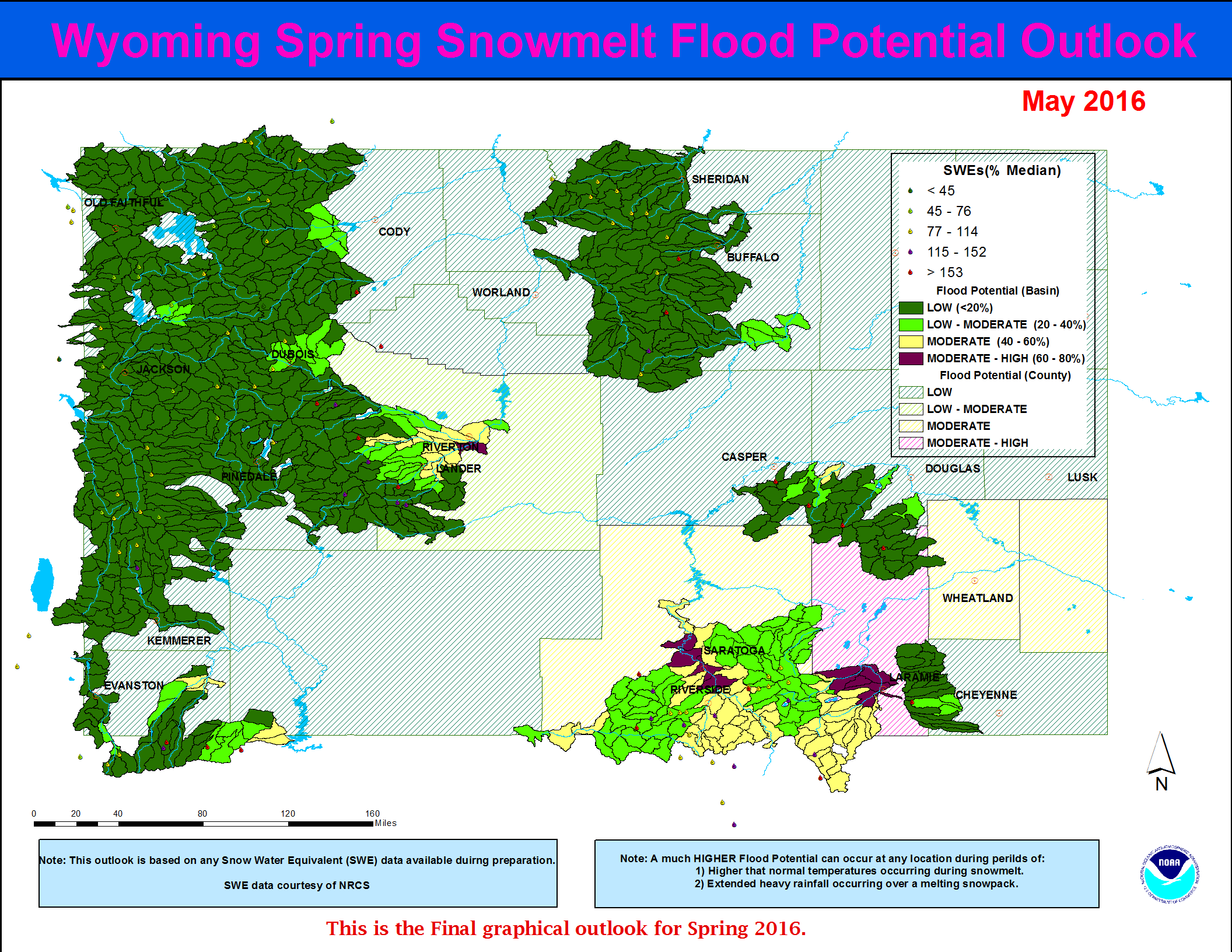
A storm system will continue to produce widespread showers and thunderstorms as it progresses eastward across the central U.S. into the Northeast through the weekend. There are risks of severe thunderstorms and excessive rainfall on Saturday from the Ozarks into the mid-Mississippi River Valley with potential for damaging winds, large hail, tornadoes, and flash flooding. Read More >
Mountain snowpack and associated snow water equivalents (SWEs) across central through western Wyoming continued to be much above average by the middle of April; while SWEs across basins in southeastern Wyoming were generally below average. SWEs at the peak snowmelt runoff elevations (8,500’ – 10.000’) continue to be the highest across the Wind and the Upper Green Basins at 170 to 190 percent of median. The Laramie, Upper North Platte, and Little Snake Drainages had SWEs at near 75 to 90 percent of median at the peak snowmelt runoff elevations.
This outlook is based on various diverse hydrological factors such as: snow water equivalents (SWEs) in the mountain snowpack, basin morphology (i.e. how basins respond to snowmelt runoff), antecedent soil moisture, amount of forest canopy damage, recent burn scars, low elevation snow depths, and likely temperature and precipitation trends during late spring/early summer.
…High potential for flooding associated with snowmelt is expected over several basins across the Little and Big Wind Watersheds…
…High potential for flooding associated with snowmelt is expected over several basins of the Upper Green Basin…
…Moderate to High potential for snowmelt flooding is expected over headwater basins of the Snake River Drainage (to include the Salt River Drainage)…
…Moderate to High potential for flooding due to snowmelt is expected over portions of the North and South Forks of the Shoshone River Basin…
…Moderate to High potential for snowmelt flooding is predicted over portions of the of the Sweetwater River Watershed…
…Moderate potential for flooding associated with snowmelt is also expected across the upper to middle portions the of the Little and Big Wind Watersheds, the middle to upper portions of the Upper Green Drainage, the lower and/or upper potions of the North/South Forks of the Shoshone Basin, the upper and lower sections of the Upper Bear Watershed, and several basins across the Snake River Watershed.
…All other headwater basins (Upper North Platte, Laramie, Little Snake, Powder, and Tongue Basins) across Wyoming can expect a generally Low potential for flooding due to springtime snowmelt...
This will be the LAST outlook for the 2017 season.
*****************************************************************************************
Other hydrological information for Wyoming can be found at the NOAA hydrology website:
https://www.weather.gov/riw/local_hydrology
Monthly Wyoming Hydrologic Summary and Graphics:
(updated monthly around the 15th of every month)
https://www.weather.gov/media/riw/hydro/hydro_report.pdf
Wyoming Drought Information Page:
(updated at least once a month)
https://www.weather.gov/riw/drought
Wyoming Graphical Water Supply Outlook:
(updated by the 10th of every month—January-June)
https://www.weather.gov/images/riw/hydro/watersupply.png
Wyoming Average Precipitation by Basin:
(updated monthly)
https://www.weather.gov/images/riw/hydro/wyomingprecip.png
Wyoming Spring Snowmelt Runoff Flood Potential Graphic:
(updated around the 20th of the month---February-April—sometimes May)
https://www.weather.gov/images/riw/hydro/floodoutlook.png
Current and Forecast Wyoming Streamflows and/or River Stages:
https://water.weather.gov/ahps2/index.php?wfo=RIW
https://water.weather.gov/ahps2/index.php?wfo=CYS
https://waterdata.usgs.gov/wy/nwis/rt
*******************************************************************************
The current Wyoming Spring 2017 Snowmelt Runoff Flood Potential Outlook graphic:
